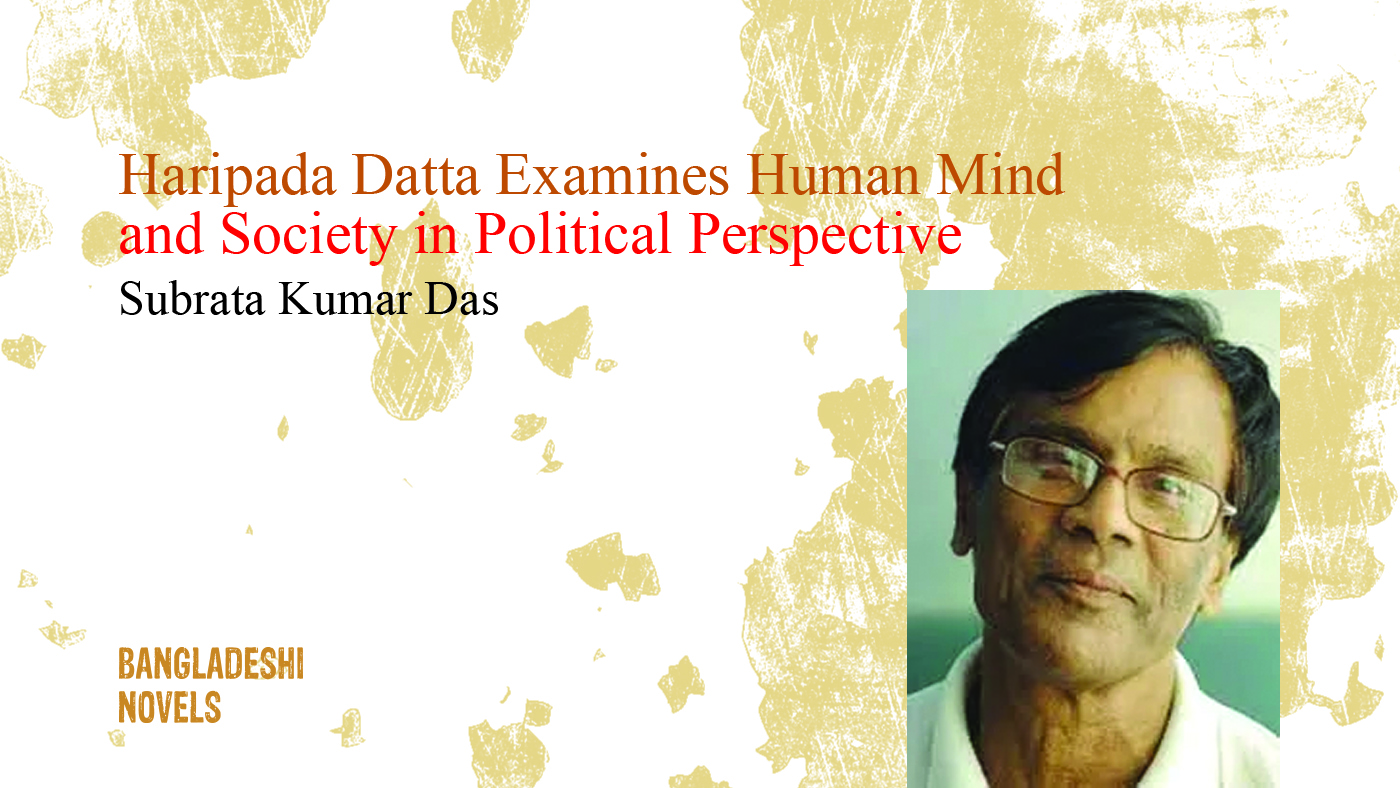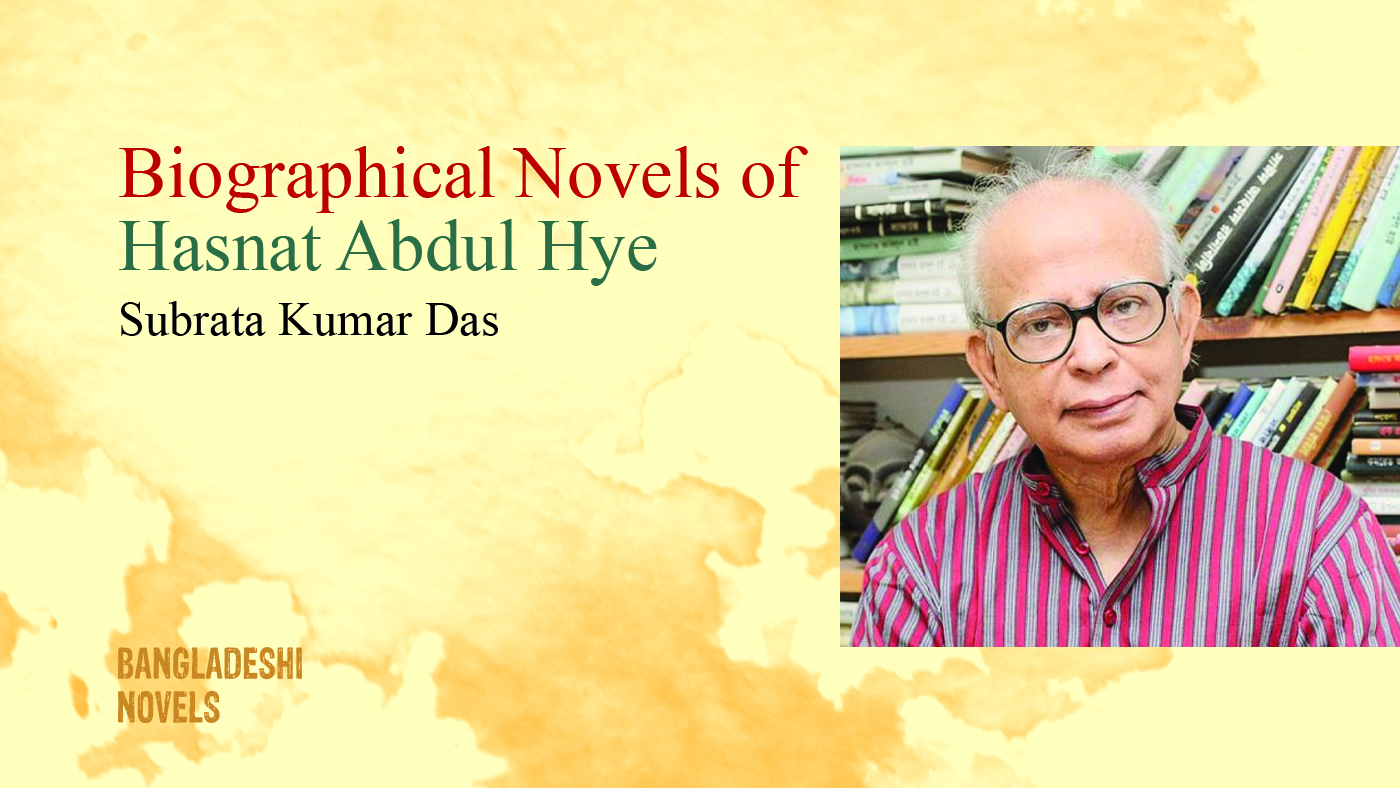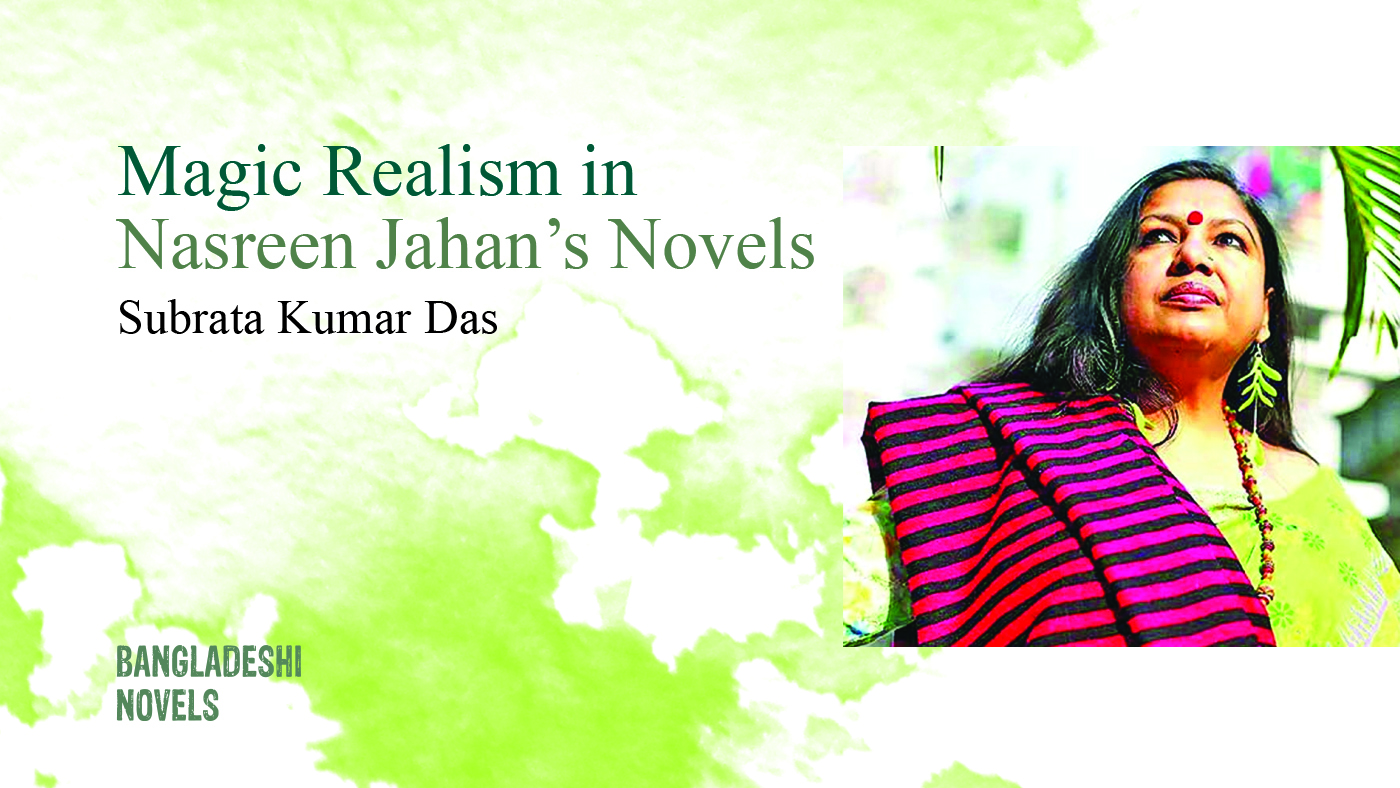
Before Syed Waliullah’s (1922-1971) Lalshalu (1948), the history of novels of Bangladesh was not very significant. No doubt, there were attempts by a good number of writers, but only a few could create impression on the readers’ mind. Mohammad Najibar Rahman’s (1860-1923) Anowara (1914), Kazi Abdul Wadud’s (1894-1970) Nodibakshe (1919), Kazi Imdadul Huq’s (1882-1926) Abdullah (published in periodicals in 1920 and in book form in 1933), Abul Fazal’s (1903-1983) Prodip O Patongyo (1940), Humayun Kabir’s (1906-1969) Rivers and Women (1945, Bangla version Nodi O Nari 1952) and Abul Fazal’s Shahashika (1946) are the important instances. Then after the partition of 1947 came out Lalshalu, the first novel of Waliullah, which demonstrated the Bangali-society in a more analytic and artistic way. But when after sixteen years his second novel Chander Amabashya (Black Moon) was published in 1964 (although it was written in 1962-63) it heralded a newer voice in our novel. His third and last novel Kando Nodi Kando (Cry River Cry 1968) exposed that voice in a more delicate and pleasing way.
Syed Waliullah was born in Chittagong. Completing his intermediate education from Dhaka Intermediate College, he got his BA from Kolkata University. At the age of twenty-three only, when he was a student of MA and served as a sub-editor in The Statesman, his volume of short stories Nayanchara was published. Excluding his second volume of short stories Dui Teer O Onyanyo Golpo, (published in 1965) he wrote more thirty-two stories, which he did not publish in any book-form. Along with fiction he had considerable mastery in plays also. His plays are Bahipeer (1960), Suranga (1964) and Tarangabhanga (1965). Waliullah was awarded with the Bangla Academy and Adamji Awards in 1961 and 1965 respectively. Urdu, French and English translations of Lalshalu were published in 1960, 1961 and 1967 titling Lal Shalu, L’Arbre Saans Racines and Tree without Roots translated by Kalimullah, Anne-Marie Thibaud and Qaisar Sayeed respectively.
Lalshalu was written before the partition of India and was published after that historic event. Right before the partition when there arose a high voice in favour of an independent state for the Muslims, Waliullah was trying to detect the falsity in pseudo-religious dogmas and practices, which voiced against freethinking and education. It is also worthy to mention that as the settlement of Pakistan was on the basis of religious rights, Lalshalu could not draw the attention of the Bangla Muslim literati. Only after the second edition of it in 1960 Lalshalu began to be popular.
In Lalshalu Syed Waliullah has portrayed the traditional superstitious Muslim society of Bangla through the story of Mojid and the ancient tomb covered with a lal (red) shalu (cotton fabric). Mojid, an outsider of the village Mohabbatnagore, arrives one day and announces that the uncared-for tomb is of a great priest of high honour which causes a sort of fear among the populace of the village and thus taking after the responsibility of looking after the tomb, Mojid begins his establishment for livelihood. Whenever there appears any sign of obstruction on the way of Mojid’s existence, he creates a circle of fear to mitigate the village people. Sometimes his existence is endangered from his own conscience also.
In the name of religious belief, Mojid has tried to grab whatever he needs. From financial assurance, he once upon a time proceeds to satiate his subconscious desire also. As a result, Rohima comes in his house as his wife but after some years he feels that the single wife is not enough for him. He begins to visualize the physical features of Hasunir Ma who helps Rohima in her household chores or of the wife of Byapari. As a consequence we get the arrival of Jomila as Mojid’s second wife. When most of the people of the village fail to earn the minimal livelihood, no sort of want can touch Mojid. From every effort of him, he only ensures about it very intentionally.
The fear that Mojid created since his emergence in the village continues till the end of the novel. Whenever Mojid feels necessity, he sharpens that sword of fear creating different spells. Regarding the traditional practices and beliefs of the villagers, Mojid preaches of his own keeping pace with the holy books. The incident in which Mojid compelled an elderly boy and his father to be circumcised contributes hugely in Mojid’s enterprise. Convincing Byapari to divorce his first wife Amena Bibi and compelling him it do it, Mojid matures his own plans only. When Akhas Ali tries to set up a school in the village, Mojid bravely meets the challenge and establishes his opinion that a mosque is far more essential. Two cases that make him perplexed are the arrival of Peer Shahib in a neighbouring village and the apparently anti-religious behaviour of Jamila. Due to the appearance of the Peer Shahib Mojid falls in a sort of footless situation, which instigates him to tackle the perilous situation at a great risk. For that turn Mojid survives but what does he do regarding Jomila?
At first Jomila seemed to Mojid a soft lump though from Jomila’s part he was not the same because on the day before marriage Mojid goes to have a look at his would-be-wife, he seemed as the father of the future groom to Jomila. Moreover, the days he comes to his house, Rahima seems to her as the mother of the groom. Through these humorous references, Waliullah has depicted the tragedy of Muslim Bangla. After some days of the marriage, Mojid discovers that Jomila is not that much submissive, she does not possess any fear in the name of religion; she is stubborn and does whatever she considers better; she denies all the shackles that Mojid wants to give her. To exhort his influence on her, one night he locks her in the tomb-shade. The night becomes stormy, as there is storm is Mojid’s own soul. After the storm when he opens the entrance of the tomb-shade, he discovers the unconscious body of Jomila, lying flat on back, having no cloths on her chest; and touching the tomb with her feet.
Lalshalu has become a true picturization of the agrarian Muslim society. From this novel the early superstitious scenario of a Muslim Bangla village could be visualised. Syed Waliullah has done it in a very artistic way. From the very beginning to the end, the compactness of plot is noteworthy. Waliullah’s narratology incurs frequent symbols that have made the readers to look for a second meaning everywhere. Moreover, the novelist has used a language that is only suitable for such a narration, which makes a distinction from the language that Mojid, uses. Thus Lalshalu has become a worthy effort in our fiction.
In both Chander Amabashya and Kando Nodi Kando, Syed Waliullah deals with tormented human mind. The agony in Chander Amabashya begins right at the moment the protagonist, the young teacher, comes across the incident of Kader’s Mian’s killing of a majhi (fisher) woman. The dilemma whether to expose it or not is the root cause of his agony. The other facets of his agony are whether Kader killed the woman, whether Kader loved the woman, or whether he saw everything correctly etc. In Kando Nodi Kando also we meet such a tormented man. Muhammad Mustafa, the most prominent character here, is that tormented person. His agony originates with the news of Khodeja’s suicide. Muhammad Mustafa thinks that his widowed aunt’s daughter Khodeja, who took shelter at Mustafa’s, believed that Mustafa would marry Khodeja. But when she received the news of Mustafa’s forthcoming marriage, she committed suicide although in reality her death was an accidental one. He begins to think that Khodeja’s departed soul has turned to a revengeful spirit, which would follow Mustafa in every step of his life. After severe agony, consequently Mustafa hangs himself.
Chander Amabashya opens with the scene when the ‘Jubak Shikshak’ (the young teacher whose name is Aref Ali but Jubak Shikshak is used mostly in the novel) discovers a young woman’s dead body near a bamboo bush. The spectacle caused so much panic in him that he began to run untidily. The night is mysterious, the whole environment is mysterious, and the event that chases him seems to him mysterious because he foresees a connection of Kader Mian with this incident. Kader Mian, the younger brother of Dadasaheb in whose house Jubak Shikshak got board and lodging, came out that night in which the incident takes place. The Jubak Shikshak could not but follow Kader Mian in that moonlit night because he was very curious about Kader Mian’s activities. It was believed that Kader Mian was a dervish i.e. a saintly person. After Jubak Shikshak’s hurried, worried and nervous flight from that inconceivable episode, he returns to his room and awaits something. At last the time comes. Kader enters and in a harsh voice asks why he ran away. He also asks Jubak Shikshak what he was doing in the bamboo bush. And then the psychoanalytic behaviour of Jubak Shikshak begins to proceed on.
The happening causes many disturbances on the innocent mind of Aref Ali. He cannot expose the truth to any other one, neither can he bear the upheaval caused by it. As a result he cannot concentrate to his regular duties. When he teaches at Barabari or even at school he cannot behave normally. Every now and then he dips into the unforgettable incident that he came across unfortunately. Next night Kader again comes and proposes to him to go to the bamboo bush where the dead body reclines. They two draw the dead body to the nearby river.
As the time passes, the agony of Aref Ali increases. The boatmen discover the dead body of Karim Majhi’s wife and that causes various rumours among the local people. Jubak Shikshak hears these but cannot participate. Gradually he breaks down within him. In such a time he asks one to call Kader. Kader comes in the night and asks Jubak Master ‘What’s your trap?’ The whole world of Jubak Master gets bewildered. Kader says, ‘It’s an accident. There’s nothing to do. What’s the profit to call me repeatedly now?’
In the meantime a new development emerges. ‘Kader admits that he himself is the killer of that woman. But it is not killing, rather it is an accident. Hearing the steps and, later on the voice of the Jubak Master outside the bamboo bush, he became puzzled and strangled the young woman’s throat. He did it not to kill her, but to stop her from crying. He cannot remember whether he pressed her throat in place of her mouth’. Aref Ali analyses the whole situation from different corners. He even talks with Kader about it in an interrogating way. From the answers of his questions, he realizes that Kader did not have any affinity to that woman. At last he says ‘I have no other way before me’. And he declares that he cannot pardon Kader anymore. As a result, he exposes the truth of the incident: first to Dadasaheb and then to the authority concerned.
Meanwhile Kader begins to threaten him by imposing all the responsibilities of the killing of the woman upon Aref Ali. Last of all Aref Ali meets Dadasaheb and tells him the only sentence that Kader Mian has killed a woman. Instantly he takes leave. And in the last chapter we see that Aref Ali is arrested in the police office and the police are blaming him for killing the woman.
In Kando Nodi Kando Muhammad Mustafa is also a tormented soul. But unlike Chander Amabashya where the different phases of complexity of human mind delineated, Kando Nodi Kando narrates the multifarious actions and / or people surrounding. The story line of this novel is very small. Muhammad Mustafa’s father, a very poor and treacherous man, settled Mustafa’s marriage with his niece Khodeja. Through many ups and downs in his life, Mustafa completes his studies and gets the job of a magistrate. By then he decides to marry a town woman. He informs it to the people of his home. Coincidentally Khodeja dies in the pond on that very day. Everyone believes that Khodeja’s death is a suicidal case because a village girl like Khodeja can never die while bathing in the pond. Receiving the news Mustafa postpones his wedding ceremony and returns home. He himself gets convinced that suicide of Khodeja is due to the settlement of his marriage with another woman. The agony deepens gradually. And at last Mustafa successfully hangs himself.
The total time-span of the novel is only one day, or to be more specific from evening to the dead of night. But the writer has very skillfully intermingled these few hours in a long fictional time. We get the bygone history of Kumurdanga, the subdivision town, where Mustafa serves. Eighty years before when a steamer-ghat was opened at Kumurdanga it was a feudal society. Gradually it turned to a muffasil town. There are a courthouse, a business centre, a small hospital and a minor school for the girls. When the steamer-company decided to replace the steamer-stoppage from Kumurdanga due to heavy silt in the nearby areas of the river, the superstitious mentality of the people of Kumuradanga got revealed. They begin to sacrifice everything they had in the river. On the other hand, we all also get the description of the village, the name of it is untold in the novel, near the Chandbaran Ghat. Mustafa was born in that village and the time spots worth mentioning are elaborately described to expose the moulding of Mustafa’s childhood. The behaviour of his parents, the social beliefs of the village people are minutely narrated.
There is no doubt that with Chander Amabashya Syed Waliullah introduced a different and uncommon narratology in Bangla novel. Before this novel the stream of consciousness technique was used in fiction but he applied this aspect more meticulously. In Lalshalu he does not use this rhetorical element, rather he was more sincere to narrate a story there. But in Chander Amabashya and Kando Nodi Kando he is more eager to expose the psychic realities of his characters.
So the fearful event that Aref Ali experiences takes repeated description in Chander Amabashya. He revises and revises the memory to make everything sure. He talks with himself and with Kader and then again revises that memory. Any careful reader would observe slight changes in these revisions and at last he himself makes a picture of his own. In Chander Amabashya the narrator is an omniscient one but in Kando Nodi Kando we get two different narrators. The novel opens on a steamer deck where the first person narrator, a cousin of Mustafa, begins to talk. Though his identity is not very clear but his role-plays very importantly. According to him, Khodeja did not commit suicide but rather it was an accident. But when Mustafa asks him about Khodeja’s death, he remains silent. Moreover, he does not expose that Khodeja actually loved him, not Mustata, and he also had an affinity to Khodeja. This narration of Mustafa’s life is intermingled with the narration of Tabarak Mian, another narrator. While listening to Tabarak Mian’s deliberation about Mustafa’s life and death on the steamer-deck, the memories of the first person narrator begin to blend. And the reader gets a mixture of the two, which supply him with a satisfactory and complete description.
Moreover, keen observation of these two novels draws the readers’ attention to the writer’s use of words synonymous to ‘perhaps’ or ‘possibly’, Tens of hundreds of times Waliullah has used these words to exhibit the inner uncertainty of human mind. A human being is inwardly never certain what he experiences through his senses. Or, he can never recall the things of past appropriately as they happened in the past.
Some critics identify foreign influences on Syed Waliullah’s last two novels. James Joyce (1882-1941), Virginia Woolf (1882-1941) Franz Kafka (1883-1924) or Albert Camus (1913-1960) are the most common names who are uttered in connection with the use of ‘stream of consciousness’ in Chander Amabashya. A reader may discover semblance between Jubak Shikshak and Joyce’s Stephen of Ulysses (1922) or, Woolf’s Mrs. Ramsay of To the Lighthouse (1927). Regarding plot a reader may find such similarities with Kafka’s The Trial (1925, Eng Translation 1937) and Camus’ The Outsider (1942, Eng Translation 1946). In connection to Kando Nodi Kando along with the aforesaid names Jean-Paul Sartre’s (1905-1980) Nausea (1938) is also referred.
But we should not forget that the genre ‘novel’ itself is an imported form. Since Bankimchandra Chattapadhyay (1838-1894) through onwards all the novelists owe hugely to foreign writers. Rather the credit that Waliullah should be awarded is that he has used them in his own way, in the context of our own society. Jubak Shikshak or Muhammad Mustafa are not characters alien to our society. They come out of this soil, its history, heritage and beliefs. The novelty of Waliullah is his detailed and investigative and interpretive study of his characters.







